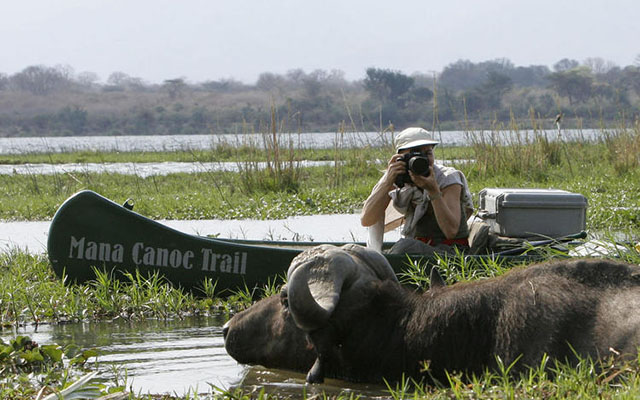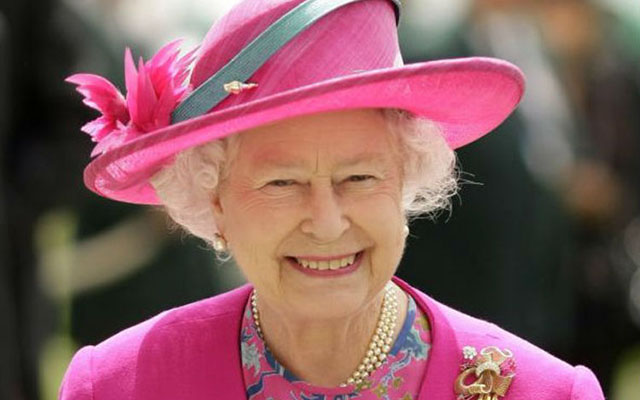Mana Pools: Never for the faint hearted


A tourist takes a photograph of a cape buffalo at Mana Pools
Isdore Guvamombe Tourism Matrix
After angrily gushing out of the wrath of the cruel turbines in its escape from Lake Kariba, the Zambezi River water appears a bit fatigued as it disappears into a narrow gorge that looks like an abyss.
Surprisingly, the river thereafter, emerges from the deep gorge reinvigorated and spreading into a flattened, fertile and vast expanse of floodplain that geomorphology condemned into twists and turns that systematically formed four (mana in Shona) pools, and ox-bow lakes.
The mighty Zambezi River flows through the Lower Zambezi Valley bordering Zimbabwe and Zambia, as a huge rift in the earth’s crust.
Over the millennia the Zambezi has rushed through this valley creating islands, channels and sandbanks.
Old river meanders, left in the mineral-rich volcanic soils, have formed into small ox-bow lakes surrounded by lush vegetation and tall old stands of mahogany and ebony.
This abundance of water and luxuriant greenery accounts for the valley’s wealth of big game.
The pools are forever bursting with a profusion of birds and animals, especially during dry season from June to October.
Welcome to Mana Pools, Zimbabwe’s second World Heritage Site and latter-day tourist attraction of choice.
Here the visitor is treated to a perfect theatre of the jungle.
Within the stunted bush shrubbery and lush vegetation surrounding the four huge pools, buffalo graze hurriedly conscious of stalking lions and appear always restless while on the trees, chirping birds somersault from one branch to another.
Under the canopy of whipping riverine trees, a spitting distance away, elegant eland mix with shaggy water buck, radiant butterflies flutter gently between flowering shrubs while dragon flies hover above lily flowers.
For those who have fallen in love with nature, the effortless aerial displays of dragonflies on the lily-studded water ponds are a spectacle to watch.
There are also flycatchers, white-collared pratincole, banded snake eagle and yellow spotted nicator birds.
It is common spectacle to see a huge elephant bull, stand on its hind legs, its trunk attempting to reach for its lunch from a sausage tree.
This is Mana Pools, where Zambezi River changed its course a long time ago due to massive siltation, forming four distinct ox-bow lakes.
The national park is home to magnificent and enormous elephants that return year after year to the same places and are well known to the locals in the area.
Big, beefy and stocky black buffalo are always about and predators like leopards, lions and cheetah are seen regularly.
The pools are also a haven for crocodiles and large hippo pods. To the south, far distant blue hills of the Zambezi Escarpment, give a good background for the human eye.
But it is the four main pools and several smaller pools scattered along the river course and the cliffs hanging over the river and floodplains that provide shelter to a large and varied wildlife population.
The Long Pool is the largest and extends some 6km in a west to east direction. Lovely big old trees, provide a shady canopy with sparse undergrowth. This makes for easy walking and is one of the reasons why this area is perfect for walking safaris.
Mana Pools National Park stretches across 2 000km² of prime Zambezi river front vegetation, much of which is inaccessible except on foot and as a result is completely virgin.
The geomorphology includes islands and sandbanks fringed by dense forests of baobab mingled indigenous trees, as well as the rugged Zambezi escarpment.
In the south, Chitake Springs is of vital importance to the interior of the park as the springs form a crucial source of water as the river systems dry up during the dry season.
Here, wildlife congregate around this precious water resource and walking safaris to the area are intensely exciting and full of action. This is recommend for more experienced safari enthusiasts.
The park is open to cars only during the dry season and during the rainy season guests have to travel by foot or by boat.
The best time to visit in terms of access and temperature is from May to early September. Late September to end of October is the best game-viewing season but temperatures will be in excess of 38 degrees Celsius for most of this period.
Canoe safaris run year round and although we do offer combination canoeing/walking during the rainy season, access into the interior of the park is very limited from December to March.
In 1984, Mana became the first national park in Zimbabwe to be designated a Unesco World Heritage Site. It has since been joined by four other Zimbabwean sites including Victoria Falls, the Great Zimbabwe Ruins, the Khami Ruins and Matobo Hills National Park.
During the rainy season, from January to March, most lodges in Mana Pools are closed and most of the big game animals move away from the river and into the escarpment.
They start returning to the riverine areas from around April, as the pools in the bush dry up. As the year progresses, increasingly large herds of elephant and buffalo are seen, as well as kudu, eland, waterbuck, zebra, impala and many other antelope. There is a wide variety of birds and the game is very relaxed about people on foot, making Mana Pools one of Africa’s best national parks for walking safaris.
There are now three permanent camps here recommend, all accessible by light aircraft — and sometimes by transfers into the park along the road or river.
Ruckomechi Camp
Just outside of Mana Pools National Park’s western boundary, Ruckomechi Camp has 10 large reed and thatch chalets with en suite facilities.
The camp was relocated a couple of years ago and the new location offers great views of both national parks on either side of the Zambezi.
Ruckomechi Camp’s guides conduct walking trips and game drives, as well as canoeing or fishing trips on the river.
Vundu Camp
Nestled on the riverbank is a simple yet comfortable bush camp with seven tents where the emphasis is on professionalism, rather than luxury.
Each tent has a porch, twin (or double) beds, and an en suite shower and a flushing toilet. There are many open living spaces, a bar and a dining room which sits on a sandy patch right next to the river. Walks, drives and canoe excursions are all possible.
Kanga Bush Camp
Kanga Bush Camp is the newest addition to Mana Pools having only opened last year. It’s located near the unspoilt Kanga Pan, allowing excellent wildlife-spotting opportunities with few other people around.
The camp consists of six canvas tents overlooking the waterhole, and the activities here focus on 4WD safaris as well as walking into areas inaccessible by car.








Comments